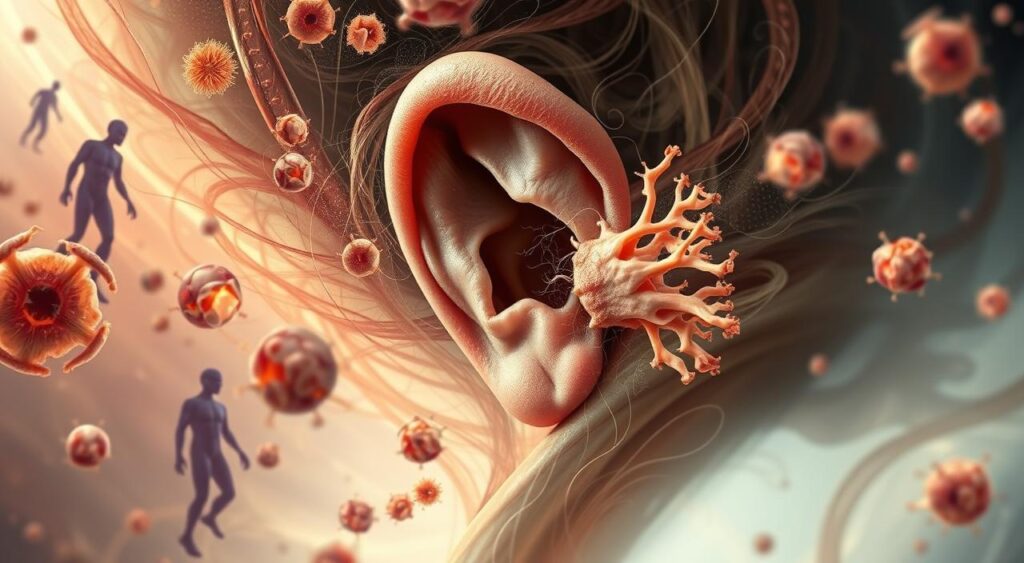Learn all about Relapsing Polychondritis, from its symptoms and causes to the available treatment options for this rare autoimmune disorder.
Relapsing polychondritis is one of them. It’s a rare autoimmune disease that harms cartilage in the body, causing inflammation and damage. Understanding its symptoms, causes, and treatments is key to managing it.

Key Takeaways
- Relapsing polychondritis is a rare autoimmune disease that affects the cartilage in the body.
- It is a chronic condition that requires ongoing management and treatment.
- The condition can cause inflammation and damage to the cartilage in various parts of the body.
- Relapsing polychondritis can have a significant impact on a person’s quality of life.
- Treatment options are available to manage the symptoms and slow down the progression of the disease.
- Early diagnosis and treatment are crucial to preventing long-term damage and improving outcomes.
Relapsing polychondritis happens when the immune system attacks the body’s cartilage. This leads to inflammation and damage. It’s a chronic condition that affects a person’s life quality. Knowing about its symptoms, causes, and treatments helps manage it better.
Understanding Relapsing Polychondritis: An Overview
Relapsing Polychondritis is a rare disease where cartilage keeps getting inflamed. It can hit different parts of the body, like the ears, nose, throat, and joints. This leads to pain, discomfort, and can make it hard to move around.
The symptoms of this disease vary from person to person. But common signs include cartilage inflammation, joint pain, and breathing issues. Knowing what Relapsing Polychondritis is and how it works is key to finding good treatments. Learning about its history and causes helps us manage it better.
Definition and Basic Characteristics
Relapsing Polychondritis is an autoimmune disease that damages cartilage. It’s hard to diagnose because its symptoms are similar to other diseases. This makes it tricky to treat.
Impact on Quality of Life
This disease can really affect a person’s life. It can cause chronic pain, tiredness, and make it hard to do simple things. Finding effective treatments is crucial to improve life for those with this condition.
Historical Background and Discovery
The history of Relapsing Polychondritis is important. It was first noted in the 1920s. Since then, we’ve learned a lot about it. Ongoing research is helping us find better ways to treat it and improve life for those with it.
| Characteristics | Description |
|---|---|
| Cartilage Inflammation | Recurring episodes of cartilage inflammation, leading to damage and loss of cartilage |
| Autoimmune Disorder | An immune system disorder that causes the body to attack its own tissues, leading to inflammation and damage |
| Inflammatory Disorder | A condition characterized by chronic inflammation, leading to pain, discomfort, and disability |
Common Signs and Early Warning Signs
Relapsing Polychondritis often shows symptoms like ear, nose, and throat issues. People might feel ear pain, hearing loss, or nasal stuffiness. These signs can point to an ear nose throat disorder. Joint pain and stiffness also show up, hinting at an autoimmune disease.
Spotting these signs early is key for quick diagnosis and treatment. Look out for:
- Ear pain or discomfort
- Hearing loss or difficulty hearing
- Nasal congestion or stuffiness
- Joint pain or stiffness, especially in hands, feet, or spine
If these symptoms don’t go away or get worse, see a doctor fast. Early action can stop long-term harm and better outcomes. Managing an autoimmune disease like Relapsing Polychondritis is crucial to ease symptoms and avoid problems.
Some people face recurring joint pain, which can really limit daily life. If you’re dealing with ongoing joint pain, getting a healthcare check-up is essential. This way, you can find out what’s causing it and get the right treatment.
Key Symptoms of Relapsing Polychondritis
Relapsing polychondritis is a chronic condition that affects many parts of the body. This includes the ears, nose, joints, and respiratory system. The symptoms can vary in severity and frequency. It’s important to seek medical attention if they persist or worsen over time.
Treatment options for relapsing polychondritis aim to alleviate symptoms and prevent long-term damage. Understanding the key symptoms of this condition is crucial for effective management and treatment.
Ear and Nose Inflammation
Ear and nose inflammation is a primary symptom of relapsing polychondritis. This can cause pain, redness, and swelling in the affected areas.
Joint and Musculoskeletal Symptoms
Joint and musculoskeletal symptoms, such as arthritis and muscle pain, are common in relapsing polychondritis. These symptoms can affect daily activities and overall quality of life.
Respiratory System Involvement
The respiratory system can also be affected, leading to symptoms such as coughing, wheezing, and shortness of breath. In severe cases, relapsing polychondritis can cause respiratory failure.
Eye-Related Complications
Eye-related complications, such as conjunctivitis and uveitis, can occur in some cases of relapsing polychondritis. These complications can cause vision problems and require prompt medical attention.
By understanding the key symptoms of relapsing polychondritis, individuals can seek medical attention early. This reduces the risk of long-term damage and improves treatment outcomes.
| Symptom | Description |
|---|---|
| Ear and Nose Inflammation | Pain, redness, and swelling in the ears and nose |
| Joint and Musculoskeletal Symptoms | Arthritis, muscle pain, and joint stiffness |
| Respiratory System Involvement | Coughing, wheezing, and shortness of breath |
| Eye-Related Complications | Conjunctivitis, uveitis, and vision problems |
Diagnosis Methods and Procedures
Diagnosing Relapsing Polychondritis, an autoimmune disorder, is tough. It’s rare and can look like other inflammatory disorders. A detailed check is key to confirm it and rule out other causes.
To diagnose Relapsing Polychondritis, doctors use several methods. These include:
- Biopsy to examine cartilage tissue for signs of inflammation
- Blood tests to detect autoimmune antibodies and inflammatory markers
- Imaging studies, such as X-rays or MRI, to evaluate cartilage and joint damage
Doctors also look at your medical history and do a physical exam. Getting the right diagnosis is vital. It helps in creating a good treatment plan.
Knowing how Relapsing Polychondritis is diagnosed helps you. It lets you work with your doctor to make a treatment plan that’s right for you.
| Diagnostic Procedure | Purpose |
|---|---|
| Biopsy | To examine cartilage tissue for signs of inflammation |
| Blood tests | To detect autoimmune antibodies and inflammatory markers |
| Imaging studies | To evaluate cartilage and joint damage |
Understanding the Causes and Risk Factors
Relapsing polychondritis is a complex autoimmune disease. It affects the cartilage and connective tissue in the body. The exact causes are still unknown, but research points to genetic and environmental factors.
Risk factors, like a family history of autoimmune diseases, can increase the chance of getting relapsing polychondritis. This knowledge is key to finding effective prevention and treatment strategies.
- Genetic predisposition: A family history of autoimmune diseases can increase a person’s risk of developing relapsing polychondritis.
- Environmental triggers: Infections, trauma, and certain medications may trigger the onset of relapsing polychondritis.
- Associated medical conditions: People with other autoimmune diseases, such as rheumatoid arthritis or lupus, may be more likely to develop relapsing polychondritis.
Understanding the causes and risk factors helps researchers and healthcare professionals. They can work towards better treatments and prevention strategies for this complex autoimmune disease.
| Risk Factor | Description |
|---|---|
| Genetic predisposition | A family history of autoimmune diseases can increase a person’s risk of developing relapsing polychondritis. |
| Environmental triggers | Infections, trauma, and certain medications may trigger the onset of relapsing polychondritis. |
| Associated medical conditions | People with other autoimmune diseases, such as rheumatoid arthritis or lupus, may be more likely to develop relapsing polychondritis. |
Treatment Options and Medical Interventions
Relapsing polychondritis is a complex autoimmune disorder. It needs a detailed treatment plan. The main goal is to manage symptoms, prevent damage, and improve life quality. Treatment includes medications, lifestyle changes, and surgery.
Medications for relapsing polychondritis include anti-inflammatory medications. These are NSAIDs and corticosteroids to reduce inflammation. Immunosuppressants are also used to control the immune system. Sometimes, biologic agents target specific molecules in inflammation.
A good treatment plan also includes lifestyle changes. This means eating well, exercising, and managing stress. Sometimes, surgery is needed to fix damaged tissues or organs.

Working with a healthcare provider is key to a personalized treatment plan. This plan combines medications, lifestyle changes, and surgery. It helps manage symptoms and improves life quality for those with this disorder.
- Medications: anti-inflammatory medications, immunosuppressants, biologic agents
- Lifestyle modifications: healthy diet, regular exercise, stress management
- Surgical interventions: repair damaged tissues or organs
Knowing the treatment options for relapsing polychondritis helps individuals manage their condition. They can improve their health and well-being by taking an active role in their treatment.
Living with Relapsing Polychondritis: Lifestyle Adjustments
Dealing with a chronic condition like relapsing polychondritis is more than just medicine. Making lifestyle changes is key to feeling better. Eating right, staying active, and managing stress are important steps.
Diet and Nutrition Guidelines
Eating a diet full of fruits, veggies, and whole grains can help. Drinking lots of water is also crucial. Keep a food diary to track any foods that might make symptoms worse.
Exercise and Physical Activity
Exercise can help with joint pain and stiffness. Try yoga, swimming, or cycling. Remember to rest when your body needs it to avoid making things worse.
Stress Management Techniques
Stress can make symptoms of relapsing polychondritis worse. Try meditation, deep breathing, or tai chi to relax. Connecting with others through support groups or online can also help.
By making these lifestyle changes, people with relapsing polychondritis can manage their symptoms better. It’s important to work with a healthcare provider to create a plan that fits your needs.
Prevention Strategies and Long-term Outlook
Relapsing polychondritis is a chronic autoimmune disease. It needs ongoing management and treatment to prevent complications. Prevention is key, combining lifestyle changes and medical care. People with this disease should work closely with their healthcare provider to create a personalized treatment plan.
This plan should consider the severity of symptoms, treatment effectiveness, and any comorbidities.
Some strategies for prevention and management of relapsing polychondritis include:
- Regular monitoring and follow-up care to prevent complications and improve outcomes
- Adherence to a treatment plan, including medication and lifestyle modifications
- Management of comorbidities, such as other autoimmune diseases or cardiovascular disease
By working closely with their healthcare provider and following a comprehensive treatment plan, individuals with relapsing polychondritis can reduce their risk of complications.

It’s important to remember that relapsing polychondritis is a complex autoimmune disease. Prevention and management need a multifaceted approach. By understanding the disease and its treatment options, individuals can actively manage their condition and improve their quality of life.
Support Resources and Patient Communities
Living with relapsing polychondritis can be tough, but you’re not alone. There are many support groups and communities to help you. They offer valuable insights, emotional support, and a sense of belonging.
Relapsing polychondritis patient communities are great for sharing experiences and learning from others. You can find them online, through social media, forums, and websites. Organizations also provide resources like educational materials, webinars, and online groups for those with relapsing polychondritis.
Access to Specialized Care
Getting specialized medical care is key for managing relapsing polychondritis. It’s important to see doctors who know how to treat this condition. Support resources can help you find these experts and get the care you need.
Some key support resources for relapsing polychondritis include:
- Online forums and social media groups
- Specialized websites and educational resources
- Patient advocacy groups and organizations
- Online directories for finding specialized medical care
By using these support resources and communities, people with relapsing polychondritis can manage their condition better. They can access important information and connect with others who get what they’re going through.
Conclusion
As we wrap up our look at relapsing polychondritis, a complex autoimmune disease, it’s key to stress the need for a full approach to handling this condition. The treatment options out there can help ease symptoms and boost your life quality. But, the path ahead needs constant watchfulness, clear talks with doctors, and a strong focus on self-care.
By keeping up with the latest info, getting help from experts and support groups, and making lifestyle changes, those with relapsing polychondritis can face its hurdles. Your health is your responsibility. By fighting for yourself and being proactive in your care, you can find better results and a more lively life.
FAQ
Q: What is Relapsing Polychondritis?
A: Relapsing Polychondritis is a rare disease. It mainly affects cartilage in the body, causing inflammation and damage. It’s a long-term condition that needs ongoing care and treatment.
Q: What are the common symptoms of Relapsing Polychondritis?
A: Symptoms include ear pain, hearing loss, and nasal congestion. Joint pain and stiffness, and breathing problems are also common. The severity and frequency of symptoms can vary.
Q: How is Relapsing Polychondritis diagnosed?
A: Doctors use lab tests, imaging, and physical exams to diagnose it. A thorough check is needed to confirm the diagnosis and rule out other causes.
Q: What are the causes and risk factors for Relapsing Polychondritis?
A: It can be caused by genetics, infections, or trauma. It’s also linked to other autoimmune diseases.
Q: What are the treatment options for Relapsing Polychondritis?
A: Treatments include medicines like anti-inflammatory drugs and immunosuppressants. Lifestyle changes like diet, exercise, and stress management are also important. Sometimes, surgery is needed.
Q: How can individuals with Relapsing Polychondritis adjust their lifestyle to manage the condition?
A: People with the condition can manage it by eating well, exercising regularly, and managing stress. Techniques like meditation or yoga can help. These changes can improve symptoms and overall health.
Q: Where can individuals with Relapsing Polychondritis find support and resources?
A: Support and resources are available through patient communities, support groups, and educational materials. These offer valuable information, emotional support, and guidance in managing the condition.
